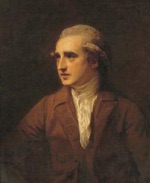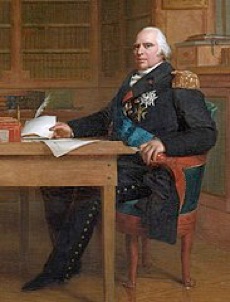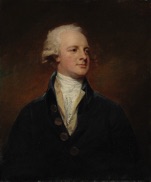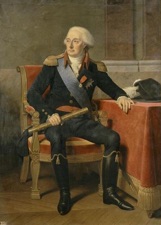JACQUES-LOUIS, comte de BOURNON




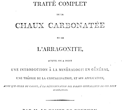
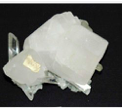
Jacques Louis de Bournon AND Haüy: FRIENDS REALLY?
THE ANGLES OF CALCITE,
A SPINE IN HAÜy’s EYES
Based on Wollaston's optical goniometer, de Bournon measures angles different from those of Haüy for calcite (105°5') versus 104°28'40'') that is to say a difference (36') which go well beyond the precision of Carangeot's mechanical goniometer (20').
These measurements also show that the crystallographic laws do not necessarily follow rational concepts "the simplest possible" as the Christianity of the abbot leads him to see.
Beyond the theory, it is Haüy's theological thought that wavers...
Calcite (with quartz, Isère, France) and aragonite (Spain ?) from the de Bournon/Louis XVIII collection.
Paris, MNHN, minéralogie.
Photo: ©MNHN
AN ÉmigrÉ IN ENGLAND
Since the French Révolution, Jacques Louis emigrated to England where, after serving in the Legitimist armies of Condé, he reorganized large private British collections where he made his major crystallographic discoveries including studies on corundum with
Sir Abraham Hume II (1749-1838) and Lord Charles Francis Greville (1749-1809).
Georges Romney: Lord Greville (1780).
©wikimedia/
thepeerage.com
attrib. to Georges Romney: Sir Hume (unknown year). ©wikimedia/Christies

From crichtonite to bournonite
Jacques Louis de Bournon described numerous species including crichtonite and humite. In return, the French mineralogist, chief of guards at the MNHN and Haüy's "assistant", Jean André Henri Lucas (1780-1825) who dedicated in 1813 bournonite that de Bournon originally named "fibrolite" as well as the species that would become sillimanite. Lucas elegantly resolved this ambiguity by renaming the first fibrolite. The American mineralogist George Thomas Bowen (1803-1828) renamed the second fibrolite to sillimanite because this mineral does not systematically form fibers.
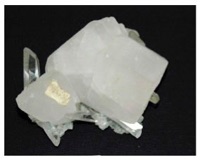
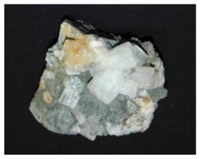

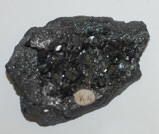
Paris, MNHN, minéralogie.
Photo: ©MNHN
Two of the bournonites
from de Bournon. These are, de facto, the types of this species.
RETURN WITH KING LOUIS XVIII
De Bournon arrived in Paris in 1815 after the Bourbon restoration and sold his collection to King Louis XVIII of France (1755-1824) who appointed him curator. In addition to the description of species, he was one of the first to describe the minerals of meteorites. Between his English exile and his return to Paris, his exchanges with Haüy were lively but courteous. Haüy's handwritten documents preserved in the Museum show that he took good note of the Count's observations. He shows that sapphire and corundum are two varieties of the same species, corundum, a discovery that will help Haüy to concretize a project on precious stones.
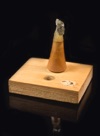

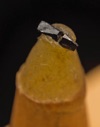

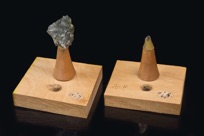
types of crichtonites (Oisans, France) on their historical and unique stands from the de Bournon/Louis XVIII collection. Paris, MNHN, minéralogie. Photos: F. Farges©MNHN
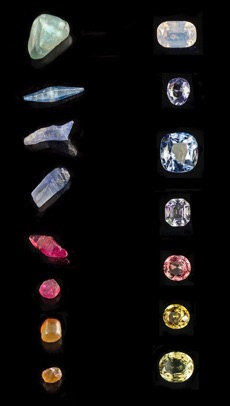
Natural and facetted corundums (neotypes) from the de Bournon/Louis XVIII collection. Paris, MNHN, minéralogie. Photos: F. Farges©MNHN

MINERAL COLLECTION
When King Louis XVIII died, his brother Charles ascended the throne as King Charles X of France. He is not interested in minerals and dissolves the private practice of his brother. De Bournon was very affected by this and died shortly after.
His collection is divided between the MNHN and the Collège de France which separates in 1990 and which the MNHN recovers in-extremis to the bulky: the collection is finally reunited. The MNHN also owns the handwritten catalog of the king's collection.

BOURBON RESTAURATION
The Restoration of the Bourbons was the second bad news for Haüy. Having almost been assassinated in September 1792 because of his adherence to the Old Regime Church (and thus, to the King's), he had become, since 1802, a close friend of Napoléon who had ordered Haüy to write, in only a few months, the famous Traité élémentaire de physique which remains, by far, Haüy's most widely distributed work (numerous reissues since 1802). The emperor had even taken the work as one of his "bedside books" during his exile in Elba.
Thus, the abbot intrigues by his too versatile friendships. If he continues to collect, to profess and to publish his researches in spite of his declining health, his material survival becomes difficult that even the nomination of canon of Notre Dame de Paris does not compensate.

THE MINERALOGICaL CABINET OF THE KING AND THE ROYAL CABINET OF MINERALOGIE
Since 1815, there are two royal cabinets of mineralogy:
-
•the "private" one, originally located at 9 place Vendôme within the l’hôtel de Villemaré then in the hotel rented from Charles Marie François Margerin de Crémont (1764-1847) located at the 8b of the place du Palais-Bourbon directed by de Bournon.
-
• the « national cabinet », which mineralogy is directed by Haüy, still located in the Jardin des plantes but renamed "Cabinet royal" because "MNHN" was too visible a mark of the Revolutionary Terror of 1793. The credits go to the first cabinet.
The three graves of the de Bournon family were found by Pierre-Jacques Chiappero (MNHN) in the Père-Lachaise cemetery in Paris: no inscription allows for clear identification (but the cemetery concession archives still allow to identify).
Jacque-Louis's sister, Charlotte de Bournon (1753-1842) is known for her numerous novels.
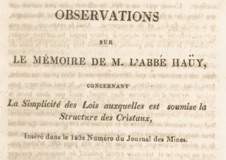
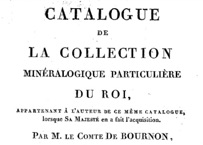
Sentence of Jacques Louis to René-Just, superbly written full of subtle toxic politeness...


But the death of the king in 1824 will end the enlightenment for de Bournon who lost his only daughter and then his wife. He retired to Versailles where he died shortly after in 1825.
French mineralogist and de Bournon’s assistant François Sulpice Beudant (1787-1850) who, by naming azurite in his first edition of his Traité élémentaire de minéralogie (1824), pays a weak tribute to his mentor (but much more to Haüy) and even forgets him in his revised version of his Traité of 1830-1832 where he names numerous mineral species - often already well known since Haüy - based on the former collection of Bournon/Louis XVIII, then already divided since 1825 between the Collège (royal) de France and the Jardin des plantes until the 1990s when the two collections are finally and logically reunited.

photos: ©P.J. Chiappero
photo: ©F. Farges/Archives nationales
photo: ©F. Farges/Archives nationales

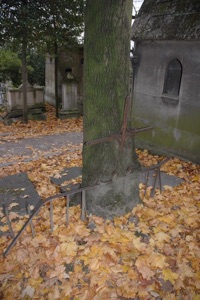
At the very moment when I was working on this cata-
log, I received from M. l'Abbé Haüy a
letter that was both extremely honest and flattering.
Alexandre François Carminade : Louis Joseph de Bourbon, Prince de Condé (1841).
©wikimedia

signature of de Bournon
photo: ©F. Farges/Archives nationales
After Romé de l'Isle and Haüy, Jacques Louis, comte de Bournon (1751-1825) is the third of the great French crystallographers. No portrait is known of him. With a solid military and naturalist education, he was passionate about mineralogy from Lorraine to Dauphiné.
Strangely, no portrait of him is known.
Michel Marigny after François Gérard: King Louis XVIII of France at the Tuileries palace (ca 1820). ©wikimedia


Abbé Haüy shares, with the Earl de Bournon, the good manners of the "people of quality" of the time. For this duel, sword or thought?

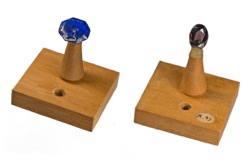
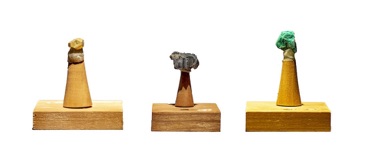
Some single crystals (native gold, bournonite and liroconite) and gems (lapis lazuli and zircon)
from the Comte de Bournon/King Louis XVIII of France collection (MNHN).

